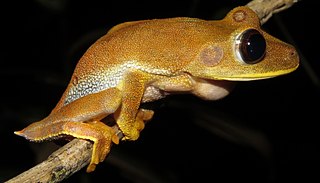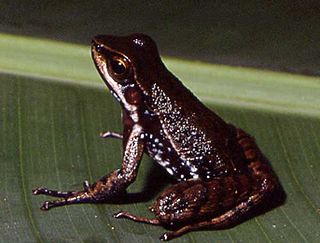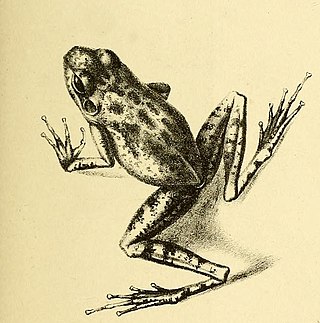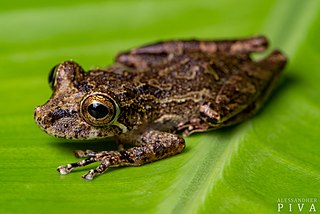
The saddleback toads (Brachycephalus) are a genus of tiny toads and frogs in the family Brachycephalidae in the order Anura, ranging from south Bahia to Santa Catarina in southeastern Brazil. The genus includes two main groups, the often brightly coloured pumpkin toadlets, and the overall brown and more frog-like flea frogs, which once were placed in their own genus Psyllophryne. Some pumpkin toadlets are toxic and their often bright colours are considered aposematic. At about 1 cm (0.4 in) or less in snout–to–vent length, the flea frogs are some of the smallest frogs in the world.

Physalaemus is a large genus of leptodactylid frogs. These frogs, sometimes known as dwarf frogs or foam frogs, are found in South America. It is very similar to Leptodactylus, a close relative, and indeed the recently described Leptodactylus lauramiriamae is in some aspects intermediate between them.

Boana pombali is a species of frog in the family Hylidae. It is endemic to south-eastern Brazil and found in Sergipe, eastern Bahia, northeastern Minas Gerais, and northern Espírito Santo states. It is named after José Perez Pombal, Jr., a Brazilian herpetologist.

Hylodes is a genus of frogs in the family Hylodidae. The genus may be paraphyletic with respect to Megaelosia. The genus Hylodes is endemic to southeastern Brazil. Member species are also known commonly as the tree toads, or more ambiguously, as torrent frogs. They are diurnal and usually inhabit shallow mountain streams.

Hylodes asper, the warty tree toad or Brazilian torrent frog, is a species of frogs in the family Hylodidae. It is endemic to the Rio de Janeiro and São Paulo states in southeastern Brazil. Living in a high-noise environment, the species uses "semaphoring" to supplement acoustic signalling.

Hylodes heyeri is a species of frog in the family Hylodidae. It is endemic to Brazil. Its natural habitats are subtropical or tropical moist lowland forest, subtropical or tropical moist montane forest, rivers, and subterranean habitats on the Atlantic side of the country. It is threatened by habitat loss.

Hylodes nasus is a species of frog in the family Hylodidae. It is endemic to Brazil. Its natural habitats are subtropical or tropical moist lowland forest and rivers. This frog has been observed 1400 meters above sea level.
Hylodes regius, also known as the royal tree toad, is a species of frog in the family Hylodidae. The specific name regius is not explained in the original species description but probably refers to the yellow and purple-red markings in male Hylodes regius. It is endemic to the Itatiaia Mountains in Minas Gerais, Brazil. After more than three decades without observations, it was detected again in 2012.

Hylodes sazimai is a species of frog in the family Hylodidae. It is endemic to Brazil. Its natural habitats are subtropical or tropical moist lowland forest, subtropical or tropical moist montane forest, and rivers. It is threatened by habitat loss.
Hylodes uai is a species of frog in the family Hylodidae. It is endemic to the Espinhaço Mountains in the Minas Gerais state, Brazil, where it is known from the Mangabeiras Park in Belo Horizonte, and another location on the southern end of the Espinhaço Mountains. It is the most-inland species of the genus.

The pumpkin toadlet, or Spix's saddleback toad, is a small and brightly coloured species of frog in the family Brachycephalidae. This diurnal species is endemic to southeastern Brazil where it is found among leaf litter on the floor of Atlantic rainforests at an altitude of 200–1,250 m (660–4,100 ft). It is found in Espírito Santo, Rio de Janeiro, southeastern São Paulo and southeastern Minas Gerais. Although its type specimen supposedly was collected in Bahia about 200 years ago, there are no confirmed localities in this state and recent reviews consider it more likely that it was from Rio de Janeiro. B. ephippium is locally common, quite widespread compared to most other species of Brachycephalus and it is not considered threatened.
Brachycephalus pombali is a species of frogs in the family Brachycephalidae. It is endemic to Brazil and only known from its type locality, "Morro dos Padres, Pico da Igreja", in the Serra do Mar in Guaratuba, Paraná state. The type locality is at about 1,300 m (4,300 ft) above sea level.
Hylodes fredi is a species of frog in the family Hylodidae, endemic to the island of Ilha Grande, Brazil.

Hylodes pipilans is a species of frog in the family Hylodidae, known to occur near the Soberbo River at Serra dos Órgãos at elevations between 245 and 814 meters above sea level, municipality of Guapimirim, and in the municipality of Cachoeiras de Macacu, both located in the state of Rio de Janeiro, Brazil. It is diurnally active.

Hylodes japi is a species of frogs in the family Hylodidae.
Hylodes caete is a species of frogs in the family Hylodidae. It is endemic to Serra do Mar, in the State of São Paulo, southeastern Brazil.

Ololygon is a genus of frogs in the family Hylidae. The majority of species in it are endemic to the Atlantic Forest of eastern Brazil, although the range of some species, including Ololygon aromothyella and Ololygon berthae, is known to extend south to northeastern Argentina, southern Paraguay, and Uruguay.
Scinax cosenzai is a species of frog in the family Hylidae. It is endemic to Brazil. People have seen it in the Parque Estadual da Serra do Brigadero in Minas Gerais.
Hylodes cardosoi is a species of frog in the family Hylodidae. It is endemic to the state of São Paulo in Brazil.











